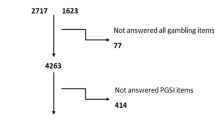Abstract
One hundred and five children of Gamblers Anonymous (GA) members and pathological gamblers in treatment were surveyed concerning behavioral, psychological, and emotional problems as well as parental use of violence. The results were compared with control groups and Jacobs' study of high school students who reported they were children of compulsive gamblers. Children of known pathological gamblers were less likely to admit to moderate or heavy use of cocaine/crack and less likely to gamble more than they could afford than either Jacobs' children of compulsive gamblers or controls. Children of pure gamblers looked more like Jacobs' controls than the self-reported children of compulsive gamblers he surveyed on several measures. Children of multiple-problem families are more likely than children of pure gamblers to smoke tobacco, get drunk, overeat, sleep “worse than most people,” have an unhappy present state of mind, and feel more insecure, inferior, or inadequate than most. GA and treatment children as a whole were more likely to say they had an unhappy childhood, and feel a need for success, acceptance, and approval than Jacobs' children of compulsive gamblers or his controls. Using Strauset al.'s “conflict tactics scale,” children of known pathological gamblers were more subject to parental violence and abuse than nationally normed samples. On most measures, the children of multiple-problem families fared worse than children of pure gamblers. However, there were no differences in the expressions of anger, hurt, sadness, depression, confusion, and other feelings between these groups concerning their parents' gambling. Treatment implications of the findings are discussed.
Similar content being viewed by others
References
Custer, R.L., & Custer, L.F. (1978).Characteristics of the recovering compulsive gambler: A survey of 150 members of Gamblers Anonymous. Paper presented at the Fourth Annual Conference on Gambling, Reno, Nevada.
Custer, R.L., & Milt, H. (1985).When luck runs out. New York: Facts on File Publications.
Deutsch, C. (1982).Broken bottles, broken dreams. New York: Teachers College Press, Columbia University.
Jacobs, D.F. (1986).Early identification and prevention of health-threatening behaviors in adolescents. Paper presented at the 21st International Congress of Applied Psychology, Jerusalem, Israel.
Jacobs, D.F. (1989). Children of problem gamblers.Journal of Gambling Behavior, 5 261–268.
Lesieur, H.R. (1979). The compulsive gambler's spiral of options and involvement.Psychiatry: Journal for the Study of Interpersonal Processes, 42 79–87.
Lesieur, H.R. (1984).The chase: career of the compulsive gambler. Cambridge, MA: Schenkman Publishing Co.
Lesieur, H.R. (1988). Altering the DSM-III criteria for pathological gambling.Journal of Gambling Behavior, 4 3–12.
Lesieur, H.R., & Klein, R. (1987). Pathological gambling among high school students.Addictive Behaviors, 12 129–135.
Lorenz, V.C. (1981).Differences found among Catholic, Protestant, and Jewish families of pathological gamblers. Paper presented at the 5th National Conference on Gambling and Risk Taking, Lake Tahoe, Nevada, October.
Lorenz, V.C., & Shuttlesworth, D.E. (1983). The impact of pathological gambling on the spouse of the gambler.Journal of Community Psychology, 11 67–76.
Lorenz, V.C., & Yaffee, R.A. (1988). Pathological gambling: Psychosomatic, emotional and marital difficulties as reported by the spouse.Journal of Gambling Behavior, 4 13–26.
Nora, R.M. (1984).Profile survey of pathological gamblers. Paper presented at the Sixth National Conference on Gambling and Risk Taking, Atlantic City, New Jersey.
Ramirez, L.F., McCormick, R.A., Russo, A.M., & Taber, J.I. (1983). Patterns of substance abuse in pathological gamblers undergoing treatment.Addictive Behaviors, 8 425–428.
Straus, M.A., Gelles, R.J., & Steinmetz, S.K. (1980).Behind closed doors: Violence in the American family. Garden City: Anchor Books.
Volberg, R.A., & Steadman, H.J. (1988). Refining prevalence estimates of pathological gambling.American Journal of Psychiatry, 145 502–505.
Wanda G., & Foxman, J. (1971).Games compulsive gamblers, wives and families play. New York: Gam-Anon National Services Office.
Wexler, A. (1980).Results of a survey of compulsive gamblers. Unpub. mimeo, Parlin, New Jersey (available through the Council on Compulsive Gambling of New Jersey, 1315 West State St., Trenton, New Jersey 08618).
Author information
Authors and Affiliations
Additional information
The authors would like to thank Mary Heineman, M.S.W., and Valerie Lorenz, Ph.D., for their comments on an earlier draft of this paper.
Rights and permissions
About this article
Cite this article
Lesieur, H.R., Rothschild, J. Children of Gamblers Anonymous members. J Gambling Stud 5, 269–281 (1989). https://doi.org/10.1007/BF01672428
Issue Date:
DOI: https://doi.org/10.1007/BF01672428




